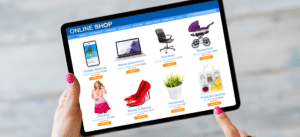10 Storytelling Secrets for eCommerce Success
eCommerce content can sometimes feel a little… sterile. Product descriptions, specs, and pricing are necessary, sure, but they don’t always connect with your audience on a deeper level.
That’s where storytelling comes in.
Storytelling isn’t just about words—it’s about creating a connection. It’s about making your audience feel something, whether it’s excitement, nostalgia, or trust. And when people feel connected to your brand, they’re more likely to buy from you.
In this blog, I’ll share 10 game-changing ways to use storytelling to elevate your eCommerce content. Some of these tips might feel like common sense, while others might make you think, “Why haven’t I tried this already?” Either way, they’ll help you create content that resonates, engages, and converts.
Key Takeaways:
- Storytelling builds emotional connections that make your brand memorable.
- Authentic, relatable stories can increase engagement, trust, and loyalty.
- Visual storytelling, customer testimonials, and behind-the-scenes narratives are powerful tools to drive sales.
- A strong story can guide customers through the buyer’s journey and inspire action.
1. Start with Your Brand Story
Every great story has a beginning, and for your eCommerce business, that’s your brand story. Why did you start your business? What challenges did you overcome? What’s the bigger purpose behind what you do?
Your brand story doesn’t have to be dramatic or groundbreaking—it just has to be real. Maybe you started your sustainable fashion brand because you were tired of seeing the environmental damage caused by fast fashion. Or perhaps your handmade jewelry business began as a creative outlet during a tough time. Whatever your story is, share it authentically.
People connect with people. And when your audience knows the “why” behind your brand, they’re more likely to support you.
2. Highlight Customer Success Stories
Let’s face it—people trust other people more than they trust brands. That’s why customer success stories are such a powerful form of storytelling.
For example, if you sell fitness equipment, you could share a story about a customer who achieved their dream of completing a marathon using your gear. Include their struggles, their journey, and how your product played a role in their success.
And don’t just stop at text. Use visuals like before-and-after photos or video testimonials. Seeing is believing, after all.
3. Create Relatable Buyer Personas
Here’s the thing—storytelling works best when your audience can see themselves in the story. That’s where buyer personas come in.
Think about your ideal customer. What are their goals? What challenges do they face? Use these insights to craft stories that speak directly to them.
For instance, if you sell camping gear, you might create a story about a busy professional who found peace and adventure on the weekends thanks to your products. It’s not just about selling gear—it’s about selling the experience.
Storytelling isn’t just about selling a product—it’s about creating an emotional connection that turns customers into loyal advocates.

4. Use Visual Storytelling
A picture is worth a thousand words. And in eCommerce, visuals can often tell a story better than text ever could.
For example, instead of just describing how your products are made, create a video that shows the process—from raw materials to the finished product. Or use Instagram Stories to share behind-the-scenes glimpses of your team at work.
Visual storytelling isn’t just engaging—it’s memorable. And in a crowded marketplace, being memorable can make all the difference.
5. Incorporate User-Generated Content
User-generated content (UGC) is storytelling at its most authentic. When your customers share their own experiences with your products, it’s like a stamp of approval from the real world.
Encourage your customers to share photos, videos, or reviews of your products in action. Then, feature this content on your website or social media.
For example, if you sell home decor, ask your customers to share how they’ve styled your products in their spaces. These real-life stories not only build trust but also show potential customers what’s possible.
6. Leverage Emotional Storytelling
At its core, storytelling is about emotion. Whether it’s joy, nostalgia, or even a little humor, tapping into your audience’s emotions can make your stories more impactful.
For instance, if you sell children’s toys, you might create a story about the joy a child feels when they unwrap a new toy. Or if you sell eco-friendly products, you could focus on the pride and satisfaction that comes with making sustainable choices.
7. Share Behind-the-Scenes Stories
People love a good behind-the-scenes story. It makes your brand feel more human and relatable.
For example, if you run a small eCommerce business, share stories about your creative process, your team, or even the challenges you’ve faced along the way. These stories give your audience a glimpse into the people behind the products, which can build trust and loyalty.
8. Focus on the Buyer’s Journey
Every buyer goes through a journey before making a purchase. And storytelling can help guide them along the way.
For example, if you sell skincare products, you might tell the story of someone struggling with acne and how they discovered your products. Show how their life improved after using your products, and include a clear call-to-action to encourage others to start their journey.
9. Use Storytelling in Product Descriptions
Product descriptions don’t have to be boring. Use storytelling to highlight the benefits of your products in a way that resonates with your audience.
For example, instead of just saying a jacket is waterproof, describe how it kept someone warm and dry during a surprise rainstorm on a hiking trip.
10. Connect Your Stories to a Larger Purpose
Finally, connect your stories to a larger purpose. Many consumers today want to support brands that align with their values, so use storytelling to show how your business is making a positive impact.
For example, if your eCommerce store donates a portion of its profits to charity, share stories about the people or causes you’ve helped.
We Build Cool
Success Stories
365 Data Centers
Discover how we rapidly rebuilt and optimized a 30-page website for 365 Data Centers, restoring their online presence and managing digital ad campaigns across key regions to drive engagement and growth.
XTECH Football Pads
Discover how we transformed XTECH Football Pads‘ digital presence, boosting their online sales and tripling website traffic through innovative website development and user experience enhancements.
BeEarth Foundation
Discover how we partnered with the BeEarth Foundation to develop a website that aligns with their mission of sustainability and global engagement. Our work has significantly increased their online visibility and engagement, supporting their efforts to promote sustainable development.
We Recycle Solar
Learn how we illuminated digital success for We Recycle Solar by completely redesigning their website to reflect their leadership in the growing solar recycling industry and implementing strategic digital advertising campaigns that enhanced their visibility at key industry events.
Preferred Home Health Care & Nursing Services
Explore how we elevated the digital presence of Preferred Home Health Care & Nursing Services by enhancing their website for better lead generation, building a dedicated site for staff recognition, and optimizing SEO for their location pages.
What Our Clients Say: Elevating Online Success
FAQs:
Answer: Storytelling helps build emotional connections with your audience, making your brand more relatable and memorable. It can increase engagement, trust, and customer loyalty.
Answer: Use storytelling to highlight the benefits of your products. For example, instead of listing features, describe how your product solved a problem or improved someone’s life.
Answer: Yes! Storytelling can guide customers through the buyer’s journey, address their pain points, and inspire action, ultimately leading to higher conversion rates.
Answer: Examples include sharing customer success stories, creating behind-the-scenes content, and using user-generated content to showcase real-life experiences with your products.
Answer: Sublyme Digital specializes in creating storytelling strategies that connect with your audience and drive results
Final Thoughts
Storytelling has the power to transform your eCommerce content. It can take your brand from being just another store to being a memorable, trusted part of your customers’ lives.
But storytelling isn’t a one-size-fits-all solution. It’s about experimenting, learning, and finding what resonates with your audience. So start small, be authentic, and watch as your stories bring your brand to life.
Let's Build Something Sublyme
Struggling to tell your brand’s story? Sublyme Digital can help you craft storytelling strategies that captivate and convert. Contact us today to learn how we can elevate your eCommerce content.



